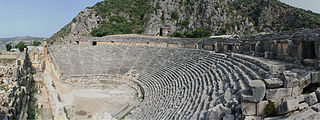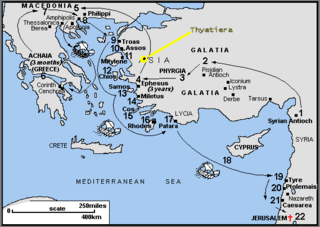
Myra was a Lycian, then ancient Greek, then Greco-Roman, then Byzantine Greek, then Ottoman town in Lycia, which became the small Turkish town of Kale, renamed Demre in 2005, in the present-day Antalya Province of Turkey. In 1923, its Greek inhabitants had been required to leave by the population exchange between Greece and Turkey, at which time its church was finally abandoned. It was founded on the river Myros, in the fertile alluvial plain between Alaca Dağ, the Massikytos range and the Aegean Sea.

Sumer is the earliest known civilization in the historical region of southern Mesopotamia, emerging during the Chalcolithic and early Bronze Ages between the sixth and fifth millennium BC. It is one of the cradles of civilization in the world, along with ancient Egypt, Elam, the Caral-Supe civilization, Mesoamerica, the Indus Valley Civilisation, and ancient China. Living along the valleys of the Tigris and Euphrates rivers, Sumerian farmers grew an abundance of grain and other crops, the surplus from which enabled them to form urban settlements. Proto-writing dates back to c. 4000 – c. 2500 BC. The earliest texts come from the cities of Uruk and Jemdet Nasr, and date to between c. 3350 – c. 2500 BC.

Smyrna was a Greek city located at a strategic point on the Aegean coast of Anatolia. Due to its advantageous port conditions, its ease of defence, and its good inland connections, Smyrna rose to prominence. The name of the city since about 1930 is İzmir.

Thebes, known to the ancient Egyptians as Waset, was an ancient Egyptian city located along the Nile about 800 kilometers (500 mi) south of the Mediterranean. Its ruins lie within the modern Egyptian city of Luxor. Thebes was the main city of the fourth Upper Egyptian nome and was the capital of Egypt for long periods during the Middle Kingdom and New Kingdom eras. It was close to Nubia and the Eastern Desert, with its valuable mineral resources and trade routes. It was a cult center and the most venerated city during many periods of ancient Egyptian history. The site of Thebes includes areas on both the eastern bank of the Nile, where the temples of Karnak and Luxor stand and where the city was situated; and the western bank, where a necropolis of large private and royal cemeteries and funerary complexes can be found. In 1979, the ruins of ancient Thebes were classified by UNESCO as a World Heritage Site.

Ancient Greece was a northeastern Mediterranean civilization, existing from the Greek Dark Ages of the 12th–9th centuries BC to the end of classical antiquity, that comprised a loose collection of culturally and linguistically related city-states and other territories. Most of these regions were officially unified only once, for 13 years, under Alexander the Great's empire from 336 to 323 BC. In Western history, the era of classical antiquity was immediately followed by the Early Middle Ages and the Byzantine period.

Polis, plural poleis, means 'city' in Greek. In Ancient Greece, it originally referred to an administrative and religious city center as distinct from the rest of the city. Later, it also came to mean the body of citizens under a city's jurisdiction. In modern historiography, the term is normally used to refer to the ancient Greek city-states, such as Classical Athens and its contemporaries, and thus is often translated as 'city-state'. The poleis were not like other primordial ancient city-states such as Tyre or Sidon, which were ruled by a king or a small oligarchy; rather, they were political entities ruled by their bodies of citizens.

Thyateira was the name of an ancient Greek city in Asia Minor, now the modern Turkish city of Akhisar, Manisa Province. The name is probably Lydian. It lies in the far west of Turkey, south of Istanbul and almost due east of Athens. It is about 50 miles (80 km) from the Aegean Sea.

Manisa Province is a province in western Turkey. Its neighboring provinces are İzmir to the west, Aydın to the south, Denizli to the southeast, Uşak to the east, Kütahya to the northeast, and Balıkesir to the north. The city of Manisa is the seat and capital of the province. The traffic code is 45.

Pinara was a large city of ancient Lycia at the foot of Mount Cragus, and not far from the western bank of the River Xanthos, homonymous with the ancient city of Xanthos.

Ladik is a city of Samsun Province, Turkey on the site of the ancient Laodicea Pontica. The mayor is Selim Özbalci (AKP).

Tripolis on the Meander – also Neapolis, Apollonia, and Antoniopolis – was an ancient city on the borders of Phrygia, Caria and Lydia, on the northern bank of the upper course of the Maeander, and on the road leading from Sardes by Philadelphia to Laodicea ad Lycum. It was situated 20 km to the northwest of Hierapolis.

A necropolis is a large, designed cemetery with elaborate tomb monuments. The name stems from the Ancient Greek νεκρόπολις nekropolis, literally meaning "city of the dead".

Various lists of the Wonders of the World have been compiled from antiquity to the present day, in order to catalogue the world's most spectacular natural features and human-built structures.

Babylon is the name of an ancient city located on the lower Euphrates river in southern Mesopotamia. Babylon functioned as the main cultural and political centre of the Akkadian-speaking region of Babylonia, with its rulers establishing two important empires in antiquity, namely the 18th century BC Old Babylonian Empire and the 7th–6th century BC Neo-Babylonian Empire, and the city would also be used as a regional capital of other empires, such as the Achaemenid Empire. Babylon was one of the most important urban centres of the ancient Near East until its decline during the Hellenistic period.

Cadyanda or Kadyanda was a town of ancient Lycia. The site was discovered by Charles Fellows. The decree of Pixodarus now in the British Museum shows that the Lycian name of the town was Xadawãti.
Hadrianopolis in Paphlagonia was a city in southwestern Paphlagonia, Asia Minor, about 3km west of modern Eskipazar.